The Nelson class were two armoured cruisers (HMS Nelson, HMS Northampton) designed by Chef Constructor Nathaniel Barnaby as an improved version of HMS Shannon, much improved. Construction was quite long due to design revision after Shannon’s own sea trials. Both were equally disappointing with an armament only valuable against coastal ironclads of the time and not fast enough to play a role in chasing off commerce raiders, a main threat for the RN at the time, played by the US, France and Russia. They were laid down at Glasgow in Elder & Co and Robert Napier yards as central battery ironclads originally and were assigned at the Australia Station in 1881 or North America and West Indies Station in 1879 respectively. In 1891 Nelson became a guardship at Portsmouth, in reserve in 1894, dockyard reserve in April 1901, hulked as stokers TS and sold in July 1910 while her sister became a boys’ training ship in 1894, paid off in 1904, sold April 1905.
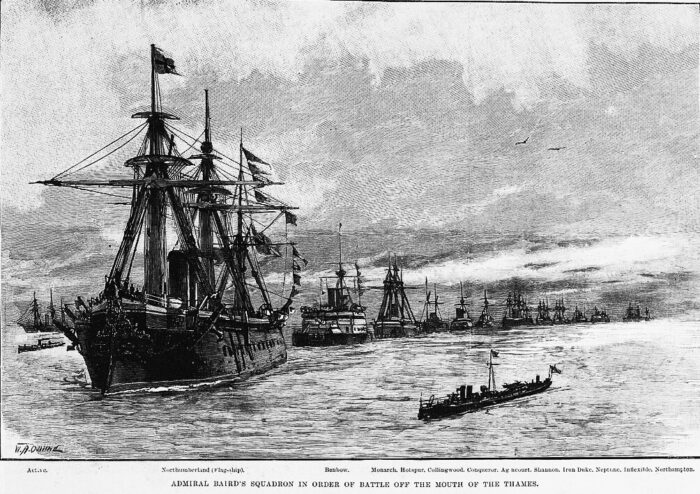
Adm. Baird’s RN squadron in order of battle for manoeuvers in the mouth of the Thames river for naval manoeuvers in 1888. Northumberland is in the lead and Noerrthampton closes the line.
The concept of the armoured cruiser had many origins and claiming nations. In the case of Russia, it is argued that the General Admiral class (1875) is a serious contender. In fact exactly the same year, the British Royal Navy claimed their own: HMS Shannon. Started in 1873 at Pembroke Dockyard, she was a repeat of the ironclad concept but on a nimbler hull (faster) with a bit less armour but longer range and defined to act independently against trade (and against defending cruisers). She was an incremental step compared to armoured frigates built a decade earlier but with a better armament and protection overall, and referred in the literature specifically as a “cruiser”, not a frigate. Soon after her, two improved ships were built, the Nelson class.

The previous HMS Shannon
Design
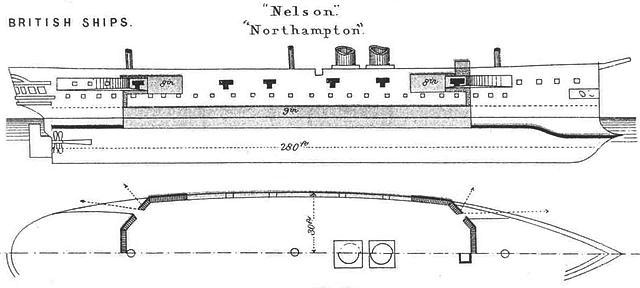
The Nelson-class were designed by Nathaniel Barnaby at the time Chief Constructor of the Royal Navy. Her already worked on HMS Shannon, considered as the very first British cruiser. These were both enlarged and improved versions and had speed, protection and armament sufficient to deal with any type of armoured frigate or converted wooden ironclad frigate of the time. The basic design was that of a central battery ironclad, with an armament all concentrated amidships.

Their opponents were typically French 2nd class Ironclads such as the Alma and La Galissonnière classes. The Audacious and Swiftsure classes later benefited from changed requirements after the construction of the first Russian armoured cruisers (General-Admiral and Gerzog Edinburgski) which started the Russo-British naval arms race.
The increased size of both vessel enabled the adoption of a more powerful machinery for an expected a 1.7 knots increase and more coal storage for extra range, plus an improved protection and better armament.
Hull and general design
The Nelsons measured perpendiculars 280 feet (85.3 m), for a beam of 60 feet (18.3 m) and a ratio of 4.7 and a deep draught of 25 feet 9 inches (7.8 m). They were thus larger than Shannon 260 x 54 x 22 ft 3 in ft or 79 x 16.5 x 6.78 m). They displaced 7,473–7,630 long tons (7,593–7,752 t) also more than Shannon (5,670 tons or about 2,000 long tons (2,000 t)). They had a steel-hull fitted with a ram but a straight prow above. The crew amounted to 560 officers and rating, also more than Shannon (452). The main reason was due to a large armament.
Armour protection layout
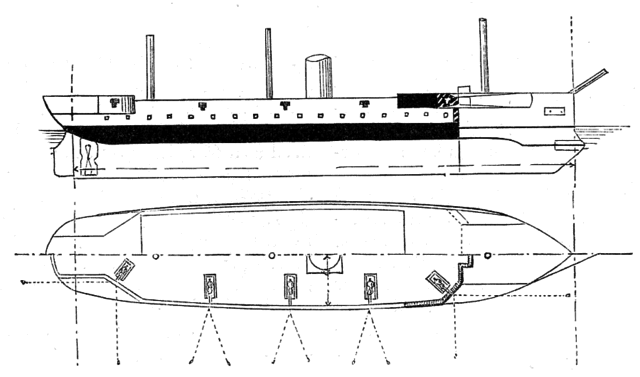
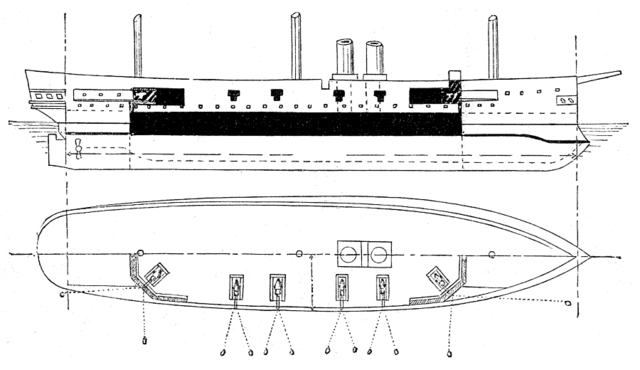
Shannon (top) and Nelson’s schemes comparison
The general distribution of armour was similar than Shannon but forward with a protective deck which was doubled by a deep bulkhead. There was an upper deck armour screen for corner gunnery ports (10-in/254mm guns) fore and aft. The added protective deck aft was enabled by twin screws rather than a single one, so that the steering gear was placed below the waterline under the 76mm lower deck. On Shannon it was protected by side armour. They had no forecastle and poop but instead a full length deck which but the battery of six 9-inches or 229mm guns remained largely unprotected but from light arms fire and shrapnel. The 25mm steel bulkheads between casemates were from splinter and raking fire (several guns being knocked out by one hit).
In short:
-Main belt, upper strake (iron): 55.2m long, 229 mm thick (9 inches) backed by teak like Shannon.
-Main belt, lower strake (iron): 55.2m long, 152mm thick (6 inches), same. Like Shannon.
-Main deck, same length: 75mm (3 inches) down to 51mm (2 inches).
-Main deck gun bulkheads: 25mm steel (1 inch) walls for splinter protection.
-Side plating abreast midships guns: 25mm steel (1 inch).
-Conning Tower likely 229mm or 9 inches
Powerplant and rigging
Both armoured ships counted on two 2/3-cylinder and inverted compound steam engines. They drove a single two-bladed 18-foot (5.5 m) propeller. Steam came from 10 oval boilers at a working pressure of 60 psi (414 kPa; 4 kgf/cm2) for an output of 6,624 indicated horsepower (4,940 kW) on Nelson) and 6,073 ihp (4,529 kW) on Northampton. The cylinders of the latter had to be adjusted in volume in order to optimize steam production (3 cylinder engines unlike Nerlson’s 2-cylinders) but they proved troublesome in service and Northampton ended 1 knot (1.9 km/h; 1.2 mph) slower than Nelson, despite efforts made to alleviate this. Help from the rigging was thus necessary to try to improve this figure, and on sea trials, Nelson reached 14 knots (26 km/h; 16 mph) as designed. Northampton failed and only reached 13.17 knots (24.39 km/h; 15.16 mph) leading to some builder’s penalties. This was rather unfortunate as Robert Napier would sign amazing engines later in the company’s career.
They carried a total of 1150 tonnes of coal for c5,000 nautical miles at 10.5 knots estimated. This was better than Shannon and her 280 tonnes and later 560 tonnes of coal.
The rigging was imposing, three masted and composites with three stages, barque rig representing 2300 m2 of sail area. Unlike Shannon they were intended mainly for steam cruising. The coal stowage to provide as enough for 7,500nm at 7 knots, unlimited under sails, but if they were reasonable sea boats, they proved to be poor sailers. The added full sail did not bring much to Northampton in service, perhaps one knot in favourable conditions.
Armament
They carried four 10-inch (254 mm) rifled, muzzle-loading guns (RML) in casemates, main battery and eight 9-inch (229 mm) RML guns on the upper deck, loosing a chase gun. This was rounded by six 20 pdr guns. This was comparable but greater than Shannon with only two 10-in MLRs, and seven 9-in MLRs instead. She gained two main guns but lost on secondary gun.
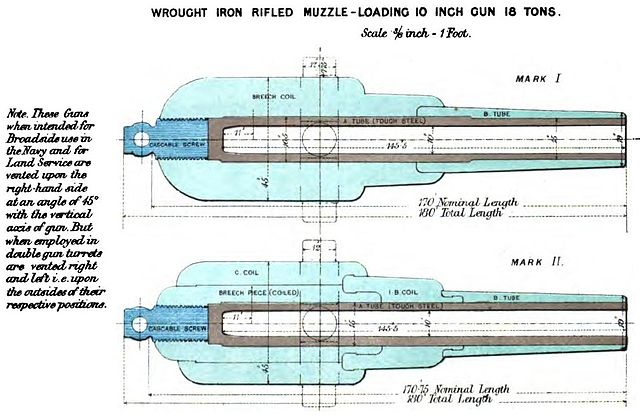
The main armament comprised 10-inch guns placed in four armoured embrasures fore and aft in the central position. These were recent RML 10-inch guns Mk II, large rifled muzzle-loading guns designed for battleships and monitors, entering service in 1868. They fired 400 to 410 pounds (181.4 to 186.0 kg) Palliser, Common, Shrapnel shell at 1,364 to 1,028 fps, up to 6,000 yards (5,500 m)
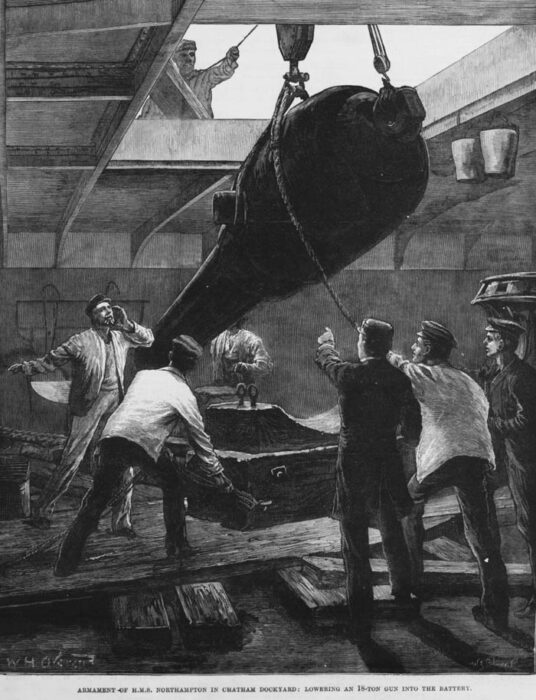
The 9-inch guns were on the open deck amidships, Mark II rifled muzzle-loading models entering service in 1865. At 12 tons for 125 inches (3.2 m) barrel they fired a 250 to 256 pounds Palliser, Common, Shrapnel at 1,420 fps (430 m/s) up to 9,919 yards (9,070 m), so they fires 1/3 further than the main guns.
Unlike Shannon she missed the detachable ram. It was fixed on both vessels. The propellers were neither detachable (lifted) for sailing. Both features were considered unnecessary complications.
They also had from the start six 20-pounder (9 kg) breech-loading guns on the upper deck as well.
In 1886, Northampton had a new military rig with fighting tops and lost six 20 pdr (100mm/21) and three 3 inches (76mm)/16 guns for the addition of six 12-pdr or 57mm/40 Hotchkiss Mk I, and eight 6 pdr or 47mm/40 Hotchkiss Mk I, as well as two 15 inches (356mm) Torpedo tibes above water in the beam.
Her sister Neslon was completely rebuilt in 1889-1891. She also received a military rig with fighting tops, fore and mizzen. She had a torpedo net added. She lost her 20-pdr guns and three of her 3-inches guns for four single 4.5 inches or 120mm/40 QF Mk I/II/III/IV guns and six 12 pdr or 57mm/40 Hotchkiss Mk I, and fourtnee 6-pdr or 47mm/40 Hotchkiss Mk I, as well as two 15 inches TTs like her sister.
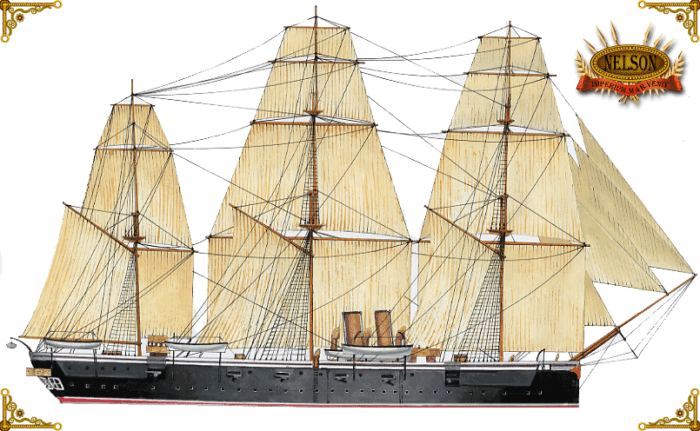
Author’s rendition of HMS Nelson
⚙ Nelson specifications |
|
| Displacement | 7,473–7,630 long tons (7,593–7,752 t) |
| Dimensions | 280 x 60 ft x 25 ft 9 in (85 x 18 x 7.8m) |
| Propulsion | 2 shafts, 2 compound-expansion steam engines, 10 boilers, 6000-6600 shp |
| Rig | Barque-rigged |
| Speed | 14 knots (26 km/h; 16 mph) |
| Range | |
| Armament | 4× 10-in RML, 8× 9-in RML, 6× 20 pdr |
| Protection | Belt: 6–9 in (152–229 mm), see notes |
| Crew | 560 |
 HMS Nelson
HMS Nelson
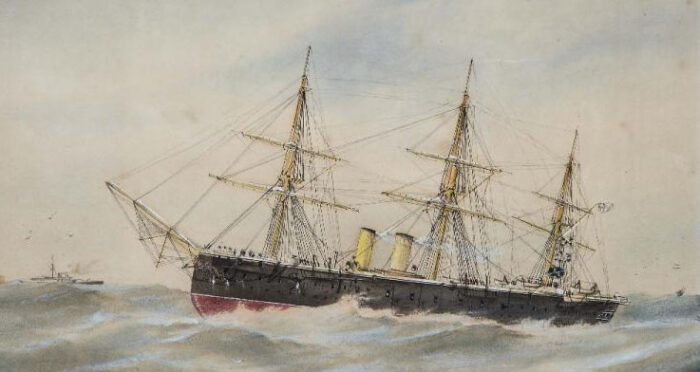
Named after the famous Napoleonic era admiral, Lord Horatio Nelson, she was laid down at Elder & Co., Glasgow on 2 November 1874, launched on 4 November 1876 but only completed on 26 July 1880 at a cost of £303,310 for the hull and £87,545 for the machinery (£390,865 total). She was first posted at the Australia Station after commissioning and as flagship from 1885. She sailed for home in January 1889 for a long refit and rearmament. She then became guardship at Portsmouth from October 1891, until 1894. She was placed in fleet reserve later taat year in November. She ended in dockyard reserve from April 1901 (small guard crew). She was hulked in November and became a training ship for stokers. Her last captain was Cr. Harry Stileman on 12 June 1902, and from February 1903 Price Vaughan Lewes. She was eventuallt stricken and sold for scrap in July 1910 for £14,500.

Nelson in 1880

Nelson at Sydney in 1885
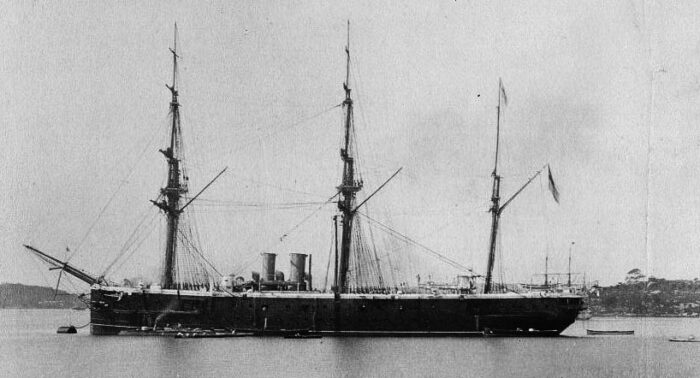
Nelson in Sydney 1887
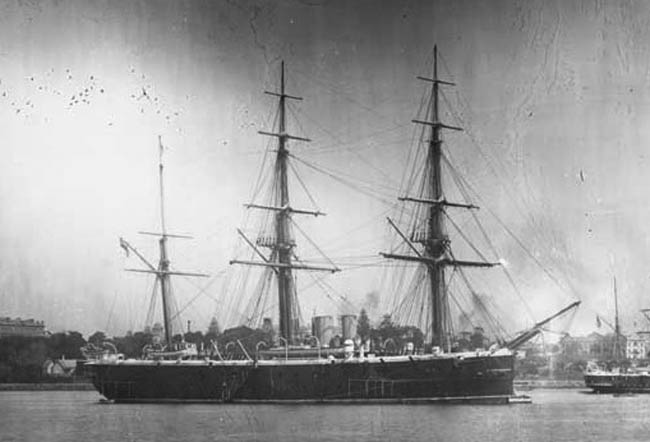
Nelson moore off farm cove Sydney
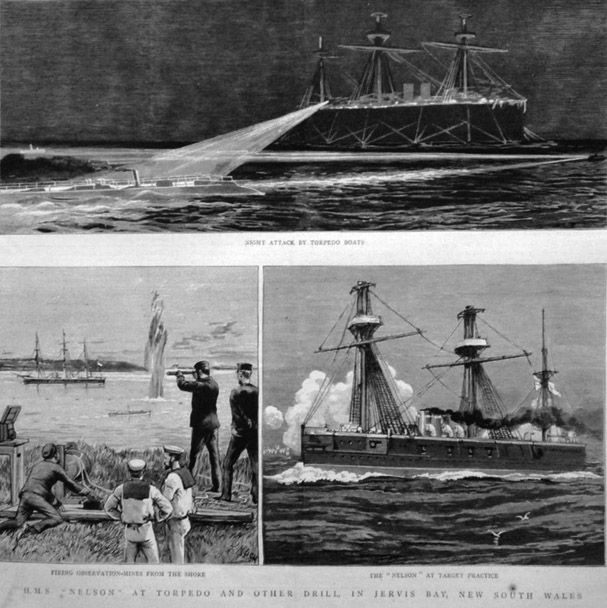
Nelson in torpedo drills Jervis Bay 1888
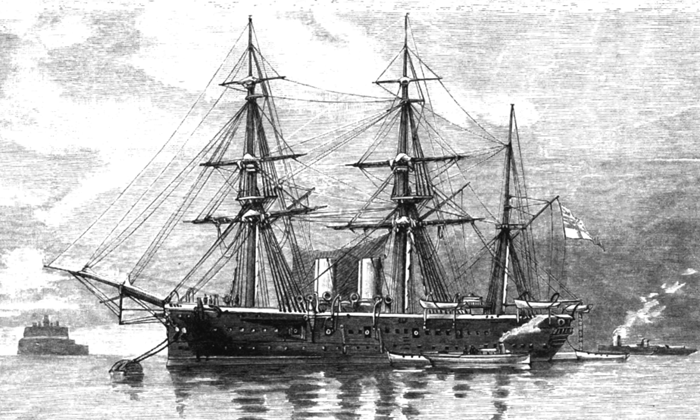
Nelson engraving, Britsh Navy vol. I 1882
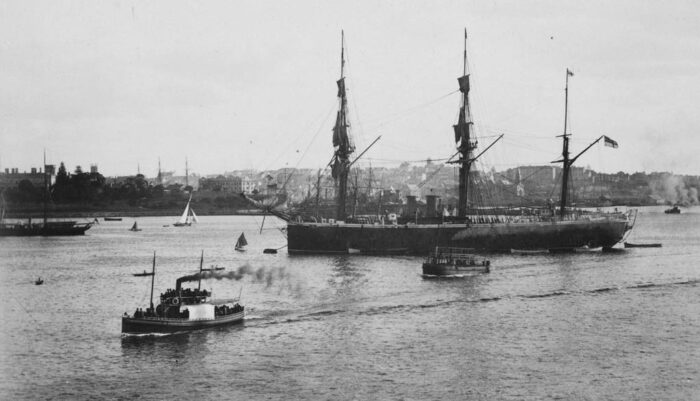
Nelson in Sydney
 HMS Northampton
HMS Northampton
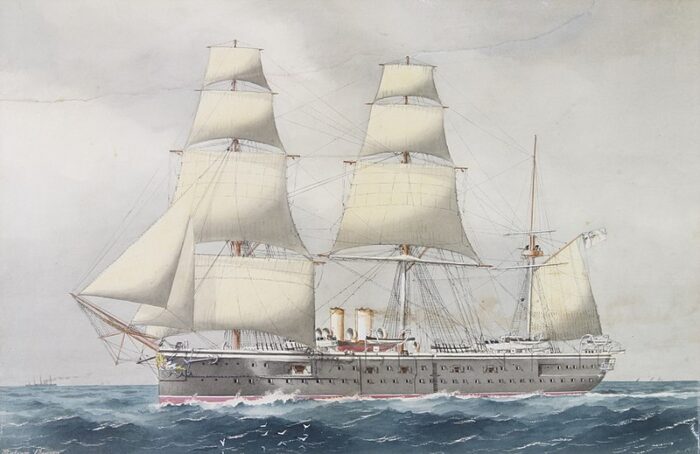
HMS Northampton was laid down at Robert Napier and Sons of Glasgow with the engine made by John Penn and Sons (same as Nelson) on 26 October 1874, launched on 18 November 1876 and completed on 7 December 1878 with the hull costing £296,836 and machinery £98,968 for a totak of £395,804. Northampton was flagship of the North America and West Indies Station until she was placed in reserve in 1886. She was hulked as a boys’ training ship in 1894 and used in home waters. Captain Herbert Arthur Walton Onslow was in command from July 1897 to February 1902. After a refit in late 1899, she left in March 1900 for an extended recruiting cruise until August that year, visiting Portsmouth, Plymouth, Queenstown, Tarbert, Foynes, Lough Swilly, Campbeltown, Holyhead and Torbay. In November 1901 she put up at Chatham Dockyard for alterations and a refit, and was not finished until June the following year, when she was back as a training cruiser. Captain William G. White was in command in 1902, when she took part in the fleet review held at Spithead on 16 August 1902 for the coronation of King Edward VII. Captain Arthur John Horsley was appointed in command in October 1902. She was sold for breaking up in 1905 to Thos. W. Ward, of Morecambe.
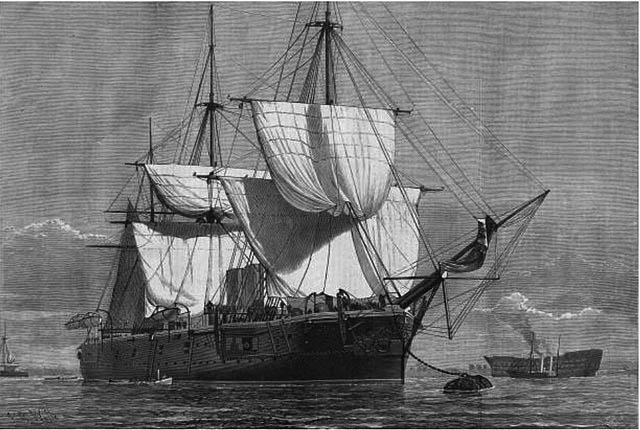
Northampton as completed
Read More
Books
John Beeler, Birth of the Battleship – British capital ship design 1870–1881, Chatham Publishing, 2001
Brassey, T.A. (ed) The Naval Annual 1895
Chesneau, Roger & Kolesnik, Eugene M., eds. (1979). Conway’s All the World’s Fighting Ships 1860–1905.
Colledge, J. J.; Warlow, Ben (2006) [1969]. Ships of the Royal Navy, Complete Record, Chatham Publishing.
Friedman, Norman (2012). British Cruisers of the Victorian Era. Barnsley, South Yorkshire, UK: Seaforth
David Lyon, The Ship – Steam, steel and torpedoes, National Maritime Museum, 1980
Parkes, Oscar (1990). British Battleships (reprint of the 1957 ed.). NIP
Silverstone, Paul H. (1984). Directory of the World’s Capital Ships. Hippocrene Books.
Sondhaus, Lawrence Naval Warfare 1816–1914. Routledge, London, 2001.
Links
https://web.archive.org/web/20030223015143/http://www.clydesite.co.uk/clydebuilt/
https://www.navypedia.org/ships/uk/brit_cr_nelson.htm
https://www.battleships-cruisers.co.uk/nelson_class1.htm

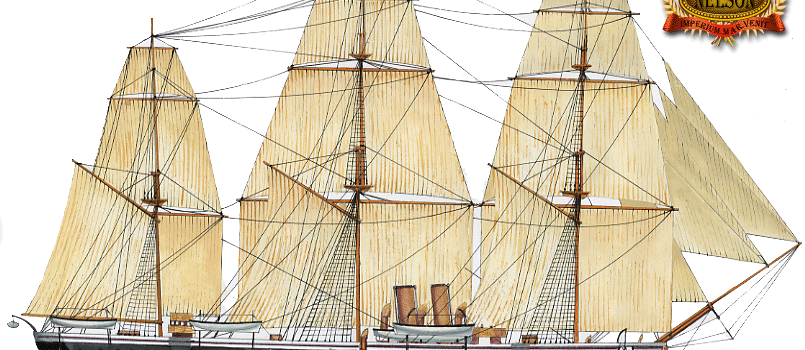
 Latest Facebook Entry -
Latest Facebook Entry -  X(Tweeter) Naval Encyclopedia's deck archive
X(Tweeter) Naval Encyclopedia's deck archive Instagram (@navalencyc)
Instagram (@navalencyc)





 French Navy
French Navy Royal Navy
Royal Navy Russian Navy
Russian Navy Armada Espanola
Armada Espanola Austrian Navy
Austrian Navy K.u.K. Kriegsmarine
K.u.K. Kriegsmarine Dansk Marine
Dansk Marine Nautiko Hellenon
Nautiko Hellenon Koninklije Marine 1870
Koninklije Marine 1870 Marinha do Brasil
Marinha do Brasil Osmanlı Donanması
Osmanlı Donanması Marina Do Peru
Marina Do Peru Marinha do Portugal
Marinha do Portugal Regia Marina 1870
Regia Marina 1870 Nihhon Kaigun 1870
Nihhon Kaigun 1870 Preußische Marine 1870
Preußische Marine 1870 Russkiy Flot 1870
Russkiy Flot 1870 Svenska marinen
Svenska marinen Søværnet
Søværnet Union Navy
Union Navy Confederate Navy
Confederate Navy Armada de Argentina
Armada de Argentina Imperial Chinese Navy
Imperial Chinese Navy Marinha do Portugal
Marinha do Portugal Mexico
Mexico Kaiserliche Marine
Kaiserliche Marine 1898 US Navy
1898 US Navy Sovietskiy Flot
Sovietskiy Flot Royal Canadian Navy
Royal Canadian Navy Royal Australian Navy
Royal Australian Navy RNZN Fleet
RNZN Fleet Chinese Navy 1937
Chinese Navy 1937 Kriegsmarine
Kriegsmarine Chilean Navy
Chilean Navy Danish Navy
Danish Navy Finnish Navy
Finnish Navy Hellenic Navy
Hellenic Navy Polish Navy
Polish Navy Romanian Navy
Romanian Navy Turkish Navy
Turkish Navy Royal Yugoslav Navy
Royal Yugoslav Navy Royal Thai Navy
Royal Thai Navy Minor Navies
Minor Navies Albania
Albania Austria
Austria Belgium
Belgium Columbia
Columbia Costa Rica
Costa Rica Cuba
Cuba Czechoslovakia
Czechoslovakia Dominican Republic
Dominican Republic Haiti
Haiti Hungary
Hungary Honduras
Honduras Estonia
Estonia Iceland
Iceland Eire
Eire Equador
Equador Iran
Iran Iraq
Iraq Latvia
Latvia Liberia
Liberia Lithuania
Lithuania Mandchukuo
Mandchukuo Morocco
Morocco Nicaragua
Nicaragua Persia
Persia San Salvador
San Salvador Sarawak
Sarawak Uruguay
Uruguay Venezuela
Venezuela Zanzibar
Zanzibar Warsaw Pact Navies
Warsaw Pact Navies Bulgaria
Bulgaria Hungary
Hungary

 Bundesmarine
Bundesmarine Dutch Navy
Dutch Navy Hellenic Navy
Hellenic Navy Marina Militare
Marina Militare Yugoslav Navy
Yugoslav Navy Chinese Navy
Chinese Navy Indian Navy
Indian Navy Indonesian Navy
Indonesian Navy JMSDF
JMSDF North Korean Navy
North Korean Navy Pakistani Navy
Pakistani Navy Philippines Navy
Philippines Navy ROKN
ROKN Rep. of Singapore Navy
Rep. of Singapore Navy Taiwanese Navy
Taiwanese Navy IDF Navy
IDF Navy Saudi Navy
Saudi Navy Royal New Zealand Navy
Royal New Zealand Navy Egyptian Navy
Egyptian Navy South African Navy
South African Navy






























 Ukrainian Navy
Ukrainian Navy dbodesign
dbodesign